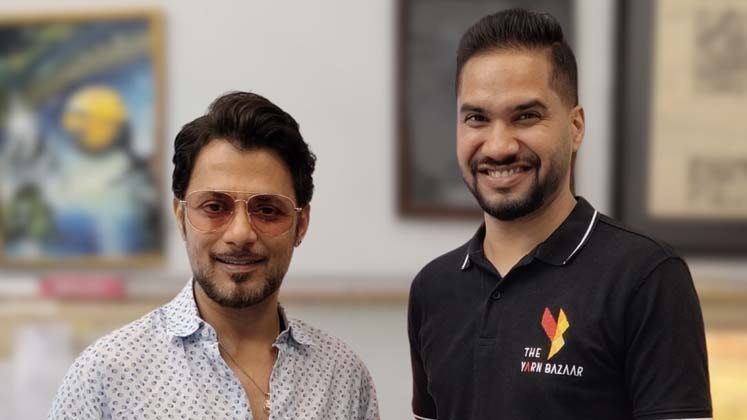Last year, The Yarn Bazaar, an online B2B managed marketplace, secured a whopping Rs. 15 crore in a pre-Series A round! This platform serves as an instrumental space, allowing buyers and sellers to promptly access real-time yarn prices, information and current market trends, making deals super transparent and efficient. Notably, during the inaugural season of Shark Tank India, The Yarn Bazaar received a funding injection of Rs. 1 crore from prominent entrepreneurs and investors, including Peyush Bansal (Co-Founder and CEO, Lenskart); Ashneer Grover (Former Founder, BharatPe); Anupam Mittal (Founder and CEO, Shaadi.Com); and Aman Gupta (Co-Founder and CMO, boAt). In an exclusive interview with Apparel Resources, Pratik Gadia, Founder and CEO – The Yarn Bazaar, spills the beans on how to ace one’s fundraising game. Here are the excerpts from the interview.
AR: Can you share your top three strategies that proved most effective in securing funding for your start-up?
PG: I believe securing funding for our start-up involved a multifaceted approach that proved to be highly beneficial. Firstly, creating and nurturing a robust pipeline of investors specialising in B2B marketplaces or those with a keen interest in lucrative industries significantly contributed to our success. Building these connections helped align our vision with their investment goals, fostering stronger partnerships.
Secondly, the importance of introduction through their network or ecosystem partners cannot be ignored. The credibility and trust established through these connections played a pivotal role in securing investor interest and confidence in our venture. Leveraging these introductions results in higher conversion rates during discussions.
Thirdly, a compelling and well-articulated pitch played a pivotal role. Stressing on the transformative nature of our idea and its potential to solve substantial industry problems while generating significant revenue was essential. Highlighting our team’s capability and the unique competitive advantage we brought to the table further bolstered investor confidence in our venture’s potential for success.
AR: What key elements or aspects of your pitch do you believe resonated most with investors?
PG: One of the pivotal elements that deeply resonated with investors was the empathetic nature of our journey. Drawing from my extensive experience in the family textile business, I intimately understand the challenges within the industry. Having navigated through those obstacles firsthand, I could present a compelling solution driven by insights gained from these experiences. This personal touch, coupled with our demonstrated track record, strongly reinforced our pitch. We didn’t just speak of empathy; we showcased tangible results. By the time we sought funding, we had concrete numbers and achievements that validated our potential for growth. It wasn’t merely about understanding the problems; it was about leveraging that understanding to build a substantial business.
AR: What crucial role did networking and building relationships play in your funding journey and what advice would you offer?
PG: Networking and cultivating relationships were instrumental in establishing trust and credibility with potential investors. Creating strong connections within the industry projected reliability and competence, making our start-up a more appealing investment prospect.
Moreover, networking offered invaluable insights. Engaging with experienced individuals provided us with crucial advice and mentorship. Their guidance helped us refine our pitch, navigate the complexities of funding and sidestep common pitfalls along the way.
Furthermore, our network acted as a wellspring of additional resources beyond funding. It offered access to talent, potential partnerships and industry expertise, all of which contributed significantly to our start-up’s success.
When starting out, prioritise relationship building in your industry. Seek mentorship, offer value and leverage connections for guidance and resources. Beyond relationship building, another valuable piece of advice would be to stay adaptable. The entrepreneurial journey is full of twists and turns and being flexible and adaptable in the face of challenges is crucial.

AR: Were there specific challenges you faced while seeking funding and how did you overcome them?
PG: We faced significant challenge in pitching to investors unaware of B2B markets, particularly within textiles. We not only encountered skepticism but also a lack of interest in our proposal. Overcoming this obstacle involved building a strategic pipeline of investors. By analysing their past investments and preferences, we aimed to connect with investors experienced in B2B markets and knowledgeable about the textile industry. This approach allowed us to engage with investors who could better comprehend our vision and appreciate the distinct value proposition our venture presented.
Apart from this, we also encountered situations where investors appreciated our venture but had misalignments regarding the business model. This is quite common in the investment landscape as each investor can possess varying perspectives on problem-solving approaches within the industry.
AR: Could you highlight any critical mistakes or lessons learned during your fundraising efforts that other start-ups need to be wary of?
PG: One key lesson learned is to treat every investor interaction as a collaborative brainstorming session. Show them your vision, why it matters and the potential scale, making these conversations an ongoing dialogue. It’s crucial to start early, engaging them gradually by sharing updates and seeking their insights. This builds rapport and familiarity. When formal discussions commence, they’ve witnessed your journey, fostering a level of trust and confidence, making it easier for them to support you.
Tips to secure seed and pre-seed investment
|
AR: How important was it to have a clear and scalable business model for attracting investor interest?
PG: At the inception of TYB, the primary aim was to revolutionise the unorganised Indian textile sector. This endeavour demanded a distinctive solution to drive substantial change. The business model, therefore, had to be not just scalable but exceptionally lucid. This vision emphasised the necessity for a clear and adaptable framework to address the complexities and challenges of the industry.
Such a business model is vital in piquing investor interest for a multitude of reasons. Firstly, it functions much like a detailed map for a hike, illustrating not just your destination (desired market and profit), but also the strategies, operations and potential challenges you’ll encounter along the way. This clarity instils trust and confidence in your ability to navigate the journey to success.
Additionally, it showcases the growth potential of your venture. Investors are intrigued by future possibilities and a scalable model demonstrates how you can expand your customer base, elevate revenue and yield significant returns. Moreover, it mitigates risks by addressing uncertainties and outlining cost management, income diversification and adaptability strategies. Lastly, in a competitive landscape, a well-defined model sets you apart, presenting your unique approach and competitive edge and making you an appealing choice for potential investors.
AR: In your experience, what were the key factors investors looked for when considering funding opportunities?
PG: Getting funding was a defining moment for us. Investors are keen on passionate founders, so my commitment and personal investment in the company were crucial. Investors often look for passionate founders with ‘skin in the game’.
They sought a substantial market size, indicating potential for significant revenue, which made our business a compelling investment. Demonstrating how we stood out in the market and our competitive edge played a pivotal role in securing their interest. Alongside, building a strong team, focused on the business and skilled in their roles, was imperative.
Highlighting scalability was the additional factor that caught their attention. It was validating to see how these aspects aligned with investors’ preferences and paved the way for our funding success.
AR: Looking back, what one piece of advice would you give to aspiring entrepreneurs seeking funding for their start-ups?
PG: A clear vision is paramount. Be precise about what you’re building, why it matters and showcase your proficiency in a specific area that you aim to scale with the raised funds. The key lies in articulating why you’re raising funds and how it aligns with achieving your goals.







